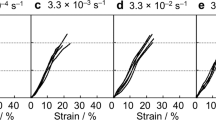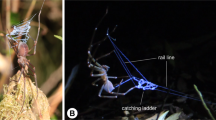Abstract
Unrestrained spider dragline 'super-contracts' when it is wetted, causing its length to shrink by about half and its diameter to almost double1,2. Here we measure the supercontraction stresses generated upon initial exposure of spider dragline to moisture and find that they are transient, as well as being greater than previously estimated. Our findings cast doubt on suggestions that supercontraction may help to maintain tension in wet webs and could limit the potential load-bearing applications of silk and its analogues.
Similar content being viewed by others
Main
It has been proposed that wetting-induced supercontraction of spider dragline silk1,2,3,4,5 takes up slack in webs, restores web shape and tension after prey capture, and opposes extensional forces exerted by the weight of precipitation on webs1,2,6,7, but these suggestions were based on extrapolated estimates of supercontraction stresses. However, advances in mechanical-testing instrumentation now allow supercontraction stress and its time dependence to be measured directly.
Figure 1 shows the evolution and decay of stress in a fixed length (30 mm) of Nephila clavipes dragline subjected to increasing humidity. Weight gain due to water absorbed by the sample makes a negligible contribution to the measured stress. The first peak in the plot of stress against time lies close to the yield strength of N. clavipes dragline (measured in a separate experiment at 30 °C, 60% relative humidity and a strain rate of 10−4 s−1). A material stressed beyond its yield strength is able to undergo bulk (visco)plastic flow. If the intrinsic resistance to flow decreases with time as a result of the plasticizing effect of rising moisture content, yield will be followed by a drop in the stress/time plot (which is what we find; Fig. 1).
Dragline was reeled13 from Nephila. clavipes at 1 cm s−1, which corresponds roughly to the rate at which silk is spun during web construction. Spiders were not anaesthe tized. The average cross-sectional area of dragline (used to convert force to stress) was estimated from diameter measurements made using light microscopy1. Forces generated by supercontraction were measured using a 10-N load cell fitted to a MicroMat 200 tensile tester (Micro Materials, Wrexham, UK). The tensile tester was housed in a benchtop environmental chamber supplied with recirculating air by an atomizing humidifier. Humidity was increased as rapidly and as greatly as the equipment would allow at the set temperature of 30 °C; the humidity increase is logarithmic over the timescale of the experiment. Further details are available from the authors.
The ability of the stress subsequently to increase once more depends on the interplay between three factors: the relationship between moisture content and polymer-chain mobility; the rate at which moisture-enabled conformational changes can occur; and the rate at which microstructural rearrangement allows the supercontraction stress to relax. Spiders may be able to control these effects through the relative amounts of crystallizable and non-crystallizable protein in their silk8, thereby optimizing the fibre for use in a particular environment. Our N. clavipes spiders were collected in Gainesville, Florida, where the daily humidity range at any time of year can be as large as the range in our experiments (US National Climatic Data Center, http://www.ncdc.noaa.gov).
The maximum supercontraction stress shown in Fig. 1 amounts to 22% of the breaking strength of the material. This result is inconsistent with estimates of the maximum supercontraction stress for dragline1,4, which is quoted as no more than 4.7% of the breaking strength. Although those measurements were made using dragline from a different spider species (Araneus diadematus), the mechanical properties of N. clavipes and A. diadematus dragline are comparable, differing by no more than a factor of 1.5 (ref. 9). The higher maximum supercontraction stress recorded here reflects the fact that we measured instantaneous force directly and continuously as humidity increased –– rather than extrapolating the force indirectly in a procedure that allows time for the supercontraction stress to relax partially.
Figure 1 also indicates that tension cannot be maintained indefinitely in a fixed length of wet dragline. After a total elapsed time of less than 5 min, the stress relaxed to zero, even though the humidity continued to rise. Although spiders might exploit supercontraction to restore the shape of a web after deformation by precipitation, wind or prey, they cannot rely on it to compensate for continued loads applied to a wet web.
Likewise, the technological applications of fibres designed to mimic spider dragline10 will be limited by stress relaxation and creep. It will be necessary to keep the fibres dry, for example by incorporating them into a water-resistant matrix11, or to eliminate moisture-sensitive sequences from the protein12.
References
Work, R. W. Textile Res. J. 47, 650–662 (1977).
Work, R. W. J. Arachnol. 9, 299–308 (1981).
Gosline, J. M., Denny, M. W. & DeMont, M. E. Nature 309, 551–552 (1984).
Work, R. W. J. Exp. Biol. 118, 379–404 (1985).
Gosline, J., Nichols, C., Guerette, P., Cheng, A. & Katz, S. in Biomimetics: Design and Processing of Materials (eds Sarikaya, M. & Aksay, I. A.) 237–261 (Am. Inst. Phys., Woodbury, New York, 1995).
Tillinghast, E. K. & Townley, M. in Ecophysiology of Spiders (ed. Nentwig, W.) 203–210 (Spinger, Berlin, 1987).
Lewis, R. V. Acc. Chem. Res. 25, 392–398 (1992).
Craig, C. L., et al. Mol. Biol. Evol. 17, 1904–1913 (2000).
Stauffer, S. L., Coguill, S. L. & Lewis, R. V. J. Arachnol. 22, 5–11 (1994).
O'Brien, J. P., Fahnestock, S. R., Termonia, Y. & Gardner, K. H. Adv. Mater. 10, 1185–1195 (1998).
Craven, J. P. Cripps, R. & Viney, C. Composites A: Appl. Sci. Manufac. 31, 653–660 (2000).
Yang, Z. et al. J. Am. Chem. Soc. 122, 9019–9025 (2000).
Thiel, B., Kunkel, D., Guess, K. & Viney, C. in Biomolecular Materials by Design (eds Alper, M., Bayley, H., Kaplan, D. & Navia, M.) 21–30 (Mat. Res. Soc., Pittsburgh, 1994).
Author information
Authors and Affiliations
Ethics declarations
Competing interests
The authors declare no competing financial interests.
Rights and permissions
About this article
Cite this article
Bell, F., McEwen, I. & Viney, C. Supercontraction stress in wet spider dragline. Nature 416, 37 (2002). https://doi.org/10.1038/416037a
Issue Date:
DOI: https://doi.org/10.1038/416037a
This article is cited by
-
Nanostructured block copolymer muscles
Nature Nanotechnology (2022)
-
Silkworm and spider silk electrospinning: a review
Environmental Chemistry Letters (2021)
-
Artificial spider silk from ion-doped and twisted core-sheath hydrogel fibres
Nature Communications (2019)
-
Non-invasive determination of the complete elastic moduli of spider silks
Nature Materials (2013)
-
Spider silk softening by water uptake: an AFM study
European Biophysics Journal (2008)
Comments
By submitting a comment you agree to abide by our Terms and Community Guidelines. If you find something abusive or that does not comply with our terms or guidelines please flag it as inappropriate.




